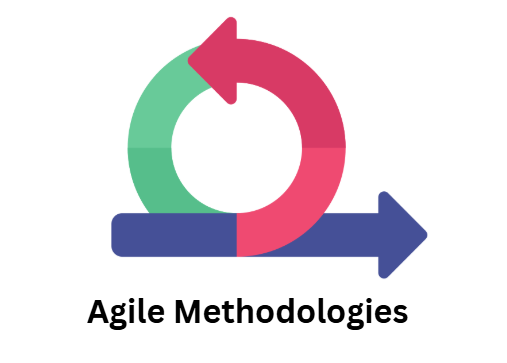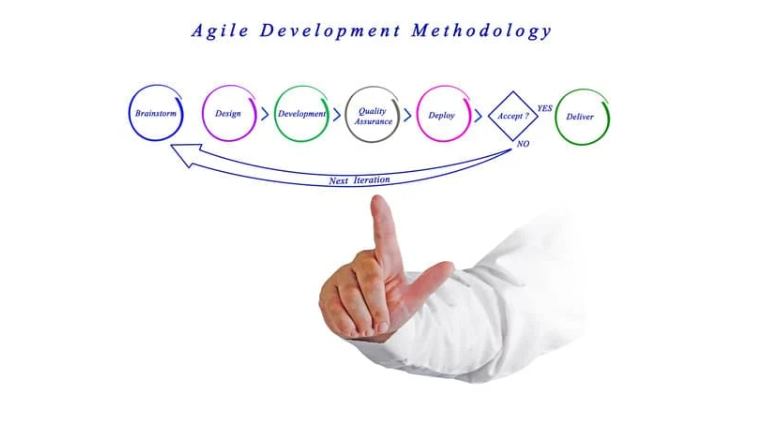As the technological landscape is rapidly changing, various advanced tools and practices are integrated into the development of projects. Agile methodology offers a modern approach for building software and project management tasks. It offers higher flexibility, and collaboration and ensures customer satisfaction and is hence highly integrated in modern development practices.
In this article, learn about agile methodologies and their importance for software development. Adapt to changing requirements, deliver faster, and experience enhanced collaboration with agile methodology.
What Are Agile Methodologies?
Agile methodologies are the new age practice and approach for project management and software development. The agile method involves breaking down a problem into parts/phases and working on improvement, collaboration, and evaluation. Agile practices are dependent on user feedback where meetings, tools, and other frameworks are used to build an application based on the user’s requirements through continuous communication and collaboration.

Agile methodology is an iterative approach in software development practice that is aligned to deliver applications based on changing business requirements. It integrates a cycle of continuous improvement in software applications followed by regular testing, review, and adjustment to deliver a high end application for users.
Why use Agile Methodologies for Software Development?
There are many advantages to using agile methodologies in software development. Let us learn about some of the most important benefits below.
- In traditional methods of software development such as waterfall methods requirements must be declared at the start, going further no changes in the product are entertained. Agile methodologies eliminate this limitation and offer to accommodate an infinite number of changes as per requirements.
- With agile methodologies, big problems are broken into small and manageable iterations which speed up the long development cycle and help build a final version of a product faster.
- Agile promotes enhanced collaboration through daily meetings, feedback collection, automated tools, reviews, and implementing communication between cross teams.
- Agile practices are more focused on delivering value to the customers and resolving their issues based on frequent feedback loops.
- End product in agile methodologies are comparatively of higher quality than compared to the traditional method of software development.
- With agile methodologies frameworks such as Scrum, Kanban, and more scalability and implement flexibility and coordination.
- Agile methodologies are highly based on continuous improvement with the help of structured loops.
Principle of Agile Methodologies In Software Development
The agile methodologies principles are based on flexibility, collaboration, rapid development, and high quality software applications. Let us learn some of the major principles used in agile.

Customer Satisfaction
Faster and high quality software end products and continuous delivery and improvement win the trust and satisfaction of users. This practice prioritises customer needs and adapts accordingly based on feedback.
Adapt to changing Requirements
Agile is a process of continuous changes and improvements through feedback loops. Agile welcomes changes based on user requirements with open hands. Frequently adapt to evolving business and customer needs in no time.
Deliver Working Software Frequently
Ensure continuous progress and quick delivery of usable features in the applications. Prioritize delivering software increments at regular intervals throughout the software development process and adjust changes afterward.
Effective Collaboration and Communication
Agile methods maintain close and continuous communication and collaboration between developers and stakeholders throughout the project development. With collaboration between cross teams, a good development environment, business goals, and ensuring the product meets the expectation.
Break the Silos
Collaboration is the key factor in agile methodologies. The goal of the agile methodology is to break projects into smaller parts and communicate more effectively. Agile focuses on meeting the objectives and needs of the organisation with enhanced collaboration and information flow.
Face to Face Communication
Agile methods offer face to face communication with frequent meetings on Zoom or Google Meet. This helps to better understand the problems and solutions through effective collaboration.
Agile Methodologies Life Cycle
The agile development cycle follows an interactive approach to software development and delivers working software quickly by dividing complex stages into smaller modules. Let us go through some of the most important stages in the Agile development life cycle.

1. Concept / Ideation
This is the first stage in the agile development life cycle which consists of aligning the vision and scope of the project. The complete product development roadmap is developed which includes finding business needs and objectives
2. Planning
This stage comprises preparing the project planning, identifying stakeholders, defining roles and responsibilities, and breaking down all requirements into smaller modules into manageable tasks. This stage consists of defining timelines, and task priority based on various stages. Every backlogs and project goals are mentioned during this phase of the agile methodologies life cycle.
3. Iteration
This stage consists of developing software through small modules and incremental cycles. All the features are developed through continuous testing, collaboration, and communication through various platforms and methods. Progress is continuously tracked and reported to stakeholders through the entire iteration phase.
4. Release & Delivery
This phase delivers a functional product increment to stakeholders or end-users. It conducts sprint reviews/demos to showcase the increment and collect feedback from stakeholders.
5. Maintenance
Monitor the product in production and address any issues or updates. Any bugs or issues in the software working are reported and fixed frequently through feedback loops and iterations. Perform routine updates to ensure the product remains functional and secure. This phase ensures a stable product with improvements.
Four Pillars of Agile In Software Development
Agile Methodologies follow four important pillars or manifestos in developing software applications.
- Collaboration, communication, and teamwork are more valued than tools and frameworks. Different methods are continuously created and integrated with continuous improvement in agile methods.
- Software delivery is more prioritized than documentation of the product. In agile methods, building high quality products is more important than creating and drafting documentation.
- Customers are more valued in this practice as building trust and effective satisfaction is considered more important. Agile teams practice collaboration with customers and stakeholders and eliminate any negotiations for long term opportunities.
- Any change or modification is quickly implemented in the final build over prioritising prior plans and following pre planned stages in software development.
Is DevOps Better than Agile Methodologies?
DevOps is an extension of agile methodologies that include continuous delivery and integration. Agile focuses more on collaboration and teamwork with divide-and-rule methods. DevOps being a broader concept is more of a process based on tools, automation, and frameworks while agile methods are generally an optimised approach and practices in software development.

DevOps offers scaling of applications, automation in deployment, effective troubleshooting, self healing, automated debugging, automated testing, easy rollbacks, continuous integration, improvement, delivery, and deployment. The agile method offers flexibility and adaptability in building rapid software for use by distributing it in smaller parts and enhancing collaboration and communication. Agile depends upon frequent feedback loops while DevOps works through continuous cycles.
Continuous Feedback Loops In Agile Methodologies
In Agile methodologies using continuous feedback loops is very important. This repeating cycle is used to collect user’s feedback and information which is evaluated and tested to make sure whether or not to integrate it in the final build.
After testing, the change is integrated and the cycle is repeated all over again. The fast feedback methods help build a more promising end product with continuous communication and collaboration through feedback from stakeholders, and other cross teams in the development. Repeated meetings, tools, and other strategies are adapted to build a high quality final product for a better user experience.
- Agile feedback loops help to maintain communication throughout the complete software development life cycle.
- Gather feedback from stakeholders, developers, designers, operations, and other different teams.
- With feedback loops, more enhanced and high quality software applications can be built.
- Identify areas of improvement and integrate them into the cycle.
- Accelerate the development of software applications through faster and more reliable techniques.
Agile Methodologies FAQs
Q1. What are agile methodologies?
Ans: Agile methodologies are the new age practice and approach for project management and software development. The agile method involves breaking down a problem into parts/phases and working on improvement, collaboration, and evaluation.
Q2. Is DevOps an agile methodology?
Ans: DevOps is a process of building a bridge connecting the software development and operation team while agile is more focused on an iterative approach which focuses on collaboration, feedback and small, rapid releases in software development.
Q3. Is DevOps better than Agile?
Ans: DevOps is an extension of agile methodologies that implement continuous integration and delivery with high levels of automation in deployment, testing, and monitoring. Agile only focuses on collaboration, feedback, and small rapid releases in software development.
Q4. How do Agile methods work?
Ans: Agile methodologies work by breaking the complete project into smaller and manageable chunks and delivering these modules to the clients within a shorter time and increasing customer satisfaction.

